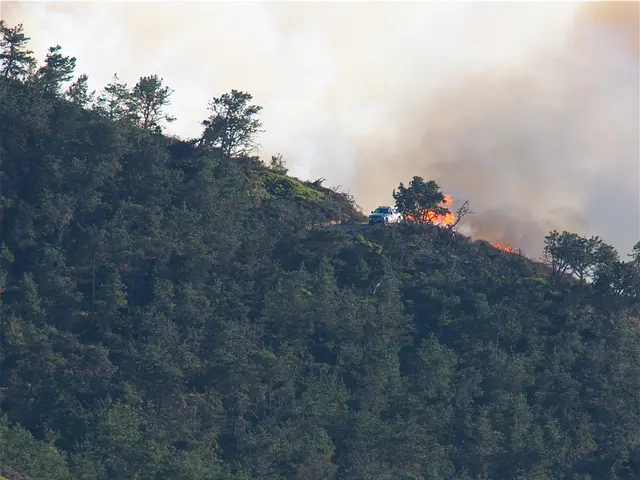Tropical Storm Erin, a powerful Category 4 hurricane, traverses the northern Caribbean islands, with no landfall predicted in its current forecast.
Hurricane Erin, a major Atlantic storm, has been making headlines due to its rapid intensification and the potential impacts it could have on various regions.
According to Dan Pydynowski, senior meteorologist at AccuWeather, Hurricane Erin has reached Category 5 status, making it one of the 43 such hurricanes on record in the Atlantic. Hurricane specialist Michael Lowry noted that Erin gained strength at an "incredible" pace, a rarity for any time of year.
The Atlantic hurricane season, which runs from June 1 to Nov. 30, is expected to be unusually busy, with six to 10 hurricanes predicted, including three to five reaching major status. The Hurricane Center has forecasted that the storm's center will remain at sea, passing north of Puerto Rico.
The Hurricane Center also warned that heavy rain in some areas could trigger flash flooding, landslides, and mudslides. Tropical storm watches have been issued for St. Martin, St. Barts, and the Turks and Caicos Islands.
Despite these warnings, Hurricane Erin's behavior exemplifies the troubling trend of hurricanes reaching major strength more quickly. Scientists have linked rapid intensification of hurricanes in the Atlantic to climate change, causing the atmosphere to hold more water vapor and spiking ocean temperatures.
Key factors linking climate change to Erin’s rapid intensification include warming ocean temperatures, increased atmospheric moisture, and favorable environmental conditions like light wind shear and compact storm structure.
Experts note that rapid intensification episodes are becoming more frequent and intense as climate change progresses, making forecasting and emergency planning more challenging. Hurricane Erin's rapid intensification is a clear example of how climate change is altering hurricane dynamics by increasing the likelihood and magnitude of such rapid strengthening events.
In preparation for Hurricane Erin, the Bahamas has prepared some public shelters as a precaution, and the U.S. government has deployed more than 200 employees from the Federal Emergency Management Agency and other agencies to Puerto Rico as a precaution.
As Hurricane Erin moves westward, powerful rip currents could affect the U.S. East Coast from Florida to the mid-Atlantic next week, despite the eye of the storm forecast to remain far offshore.
Despite tropical storm warnings, people in San Juan could be seen in the coastal waters, with some visiting beaches and wading into the water. Aarone Sargent, managing director for the Bahamas' disaster risk management authority, stated that Hurricane Erin is volatile and can make sudden shifts in movement.
Puerto Rico Housing Secretary Ciary Pérez Peña said 367 shelters were inspected and ready to open if needed. Hurricane Erin reached Category 5 status before weakening to a Category 4 storm, with maximum sustained winds of 140 mph.
As Hurricane Erin continues its path, it serves as a reminder of the potential impacts of climate change on hurricane dynamics and the importance of preparedness and vigilance.
[1] https://www.accuweather.com/en/weather-news/hurricane-erin-rapidly-intensifies-to-category-5-status-in-atlantic/1012107 [2] https://www.climate.gov/news-features/understanding-climate/what-driving-rapid-hurricane-intensification [3] https://www.washingtonpost.com/weather/2025/08/15/hurricane-erin-rapidly-intensifies-to-category-5-status-in-atlantic/ [4] https://www.nature.com/articles/s41561-020-0687-1 [5] https://www.noaa.gov/media-release/hurricane-erin-rapidly-intensifies-in-atlantic-ocean
[1] The rapid intensification of Hurricane Erin, as reported by Dan Pydynowski and Michael Lowry, has brought attention to the impact of climate change on hurricane dynamics, as warmer ocean temperatures, increased atmospheric moisture, and favorable environmental conditions contribute to its quick strengthening.
[2] The forecasted behavior of Hurricane Erin emphasizes the increasing challenge in predicting and planning for such rapid intensification events, as they are becoming more common due to the effects of climate change.








